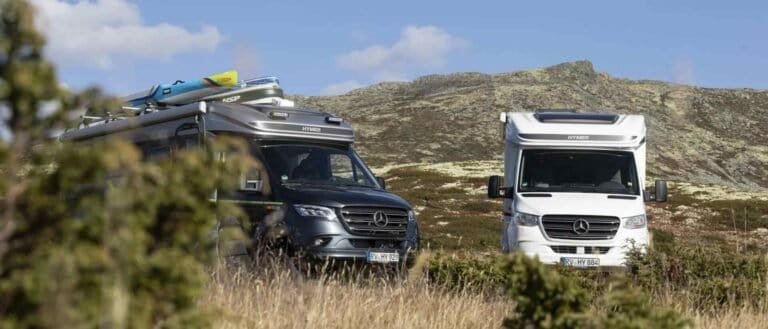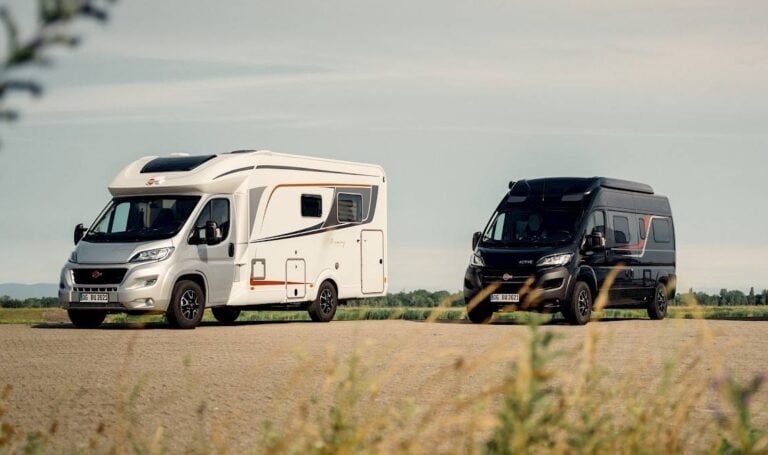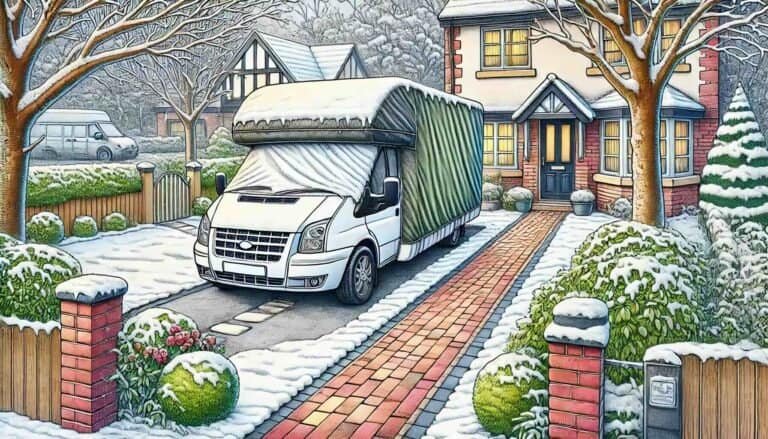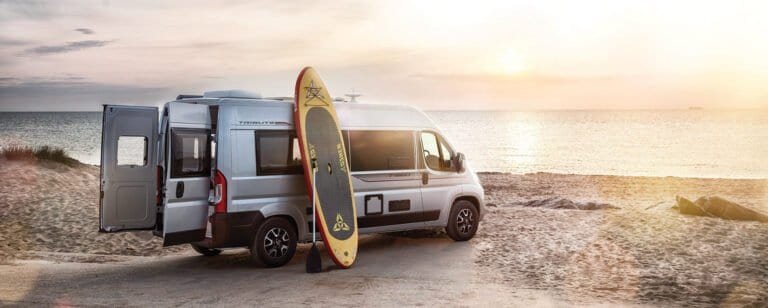Introduction
Buying a campervan or motorhome is an exciting step towards freedom and adventure on the open road, but it’s also a major investment. With so many options, features, and potential pitfalls, choosing the right vehicle can feel overwhelming. By asking the right questions before you buy, you can avoid costly mistakes, find a vehicle that meets your needs, and start your journey with confidence. This guide will walk you through the essential questions to consider, helping you make a well-informed purchase that aligns with your budget, lifestyle, and travel goals. You can also check out our guide on how to choose the perfect motorhome or campervan.
1. What Type of Campervan or Motorhome Suits My Needs?
One of the first questions to ask yourself is what’s the difference between a campervan and a motorhome and which best fits your intended use and lifestyle. Different classes of vehicles offer varying levels of comfort, storage, and handling capabilities, so understanding the differences is essential:
- Class A Motorhomes: These are the largest and most luxurious options, built on a heavy-duty frame and resembling a bus. They offer ample space and amenities but can be challenging to drive and park.
- Class B Motorhomes: Also known as campervans, Class B vehicles are more compact and resemble large vans. They’re easier to drive and park, making them ideal for solo travellers or couples.
- Class C Motorhomes: Sitting between Class A and B in size, these motorhomes are recognisable by their over-cab sleeping area. They offer more space than Class B but are generally more manageable on the road than Class A.
- Converted Vans: Customised vans are highly popular among minimalists and weekend adventurers. They can be tailored to specific needs but often lack some of the features found in purpose-built motorhomes.
Your decision will depend on factors such as:
- How often and how far you plan to travel: Larger motorhomes are great for full-time living, while smaller vans are more suited for short trips.
- Comfort vs. manoeuvrability: If you plan on exploring urban areas or narrow country roads, a smaller van may be a better fit.
- Desired amenities: Do you want a full kitchen and bathroom, or can you manage with minimalist facilities?
2. What is My Budget and Financing Plan?
Setting a realistic budget is crucial, as campervans and motorhomes come in a wide range of prices depending on size, brand, condition, and features. Here are some factors to keep in mind as you budget:
- New vs. Used: New motorhomes can come with a high price tag, but they often include warranties and modern amenities. Used vehicles, while more affordable, may require extra budget for repairs and updates. It’s important to weigh up the pros and cons of whether to buy a new or used motorhome or campervan.
- Financing Options: Consider your financing options, such as loans specific to RVs or motorhomes, which may offer favourable terms compared to personal loans.
- Additional Costs: Don’t forget to account for registration fees, taxes, insurance, and potential customisations. If you’re importing a vehicle, there may also be import duties and VAT to consider.
Your budget should allow for unexpected expenses as well. For example, a used campervan might need new tyres, or you might want to upgrade certain features. Having a solid financial plan will ensure you’re prepared for both the purchase and the ongoing costs associated with campervan ownership.
3. How Many People Will Be Using It Regularly?
The number of occupants is one of the most important factors when choosing a campervan or motorhome. This affects not only the size and layout of the vehicle but also its weight and storage capacity. Here are some points to consider based on your travel group:
- Solo Travellers and Couples: If you’re travelling alone or with a partner, you may only need a compact campervan or a Class B motorhome. These smaller options offer more flexibility for parking and manoeuvring, and they generally provide enough space for two.
- Families or Larger Groups: For families or groups, larger motorhomes like Class A or Class C vehicles offer the necessary sleeping areas, storage, and seating. Some Class A motorhomes even have bunk beds or fold-out beds to accommodate kids or additional travellers.
- Storage Needs: Larger groups also mean more belongings. Consider how much storage space you’ll need for things like clothes, food, camping gear, and toys. The layout should provide convenient access to storage areas without overcrowding the living space.
Ultimately, the size and layout of your motorhome should align with your travel group’s needs for comfort, storage, and ease of movement within the vehicle.
4. How Will I Use the Campervan or Motorhome?
Knowing how you plan to use your campervan or motorhome will guide you in choosing the right features. Think about your typical trip and travel style:
- Weekend Trips vs. Long-Term Living: For weekend getaways, you may not need a full kitchen, bathroom, or extensive storage. However, if you’re planning extended trips or even living in the vehicle full-time, a larger motorhome with more amenities (such as a full bathroom, large kitchen, and designated work area) will make life on the road more comfortable.
- Remote Travel vs. Campsite Visits: Some people prefer to travel off-grid and explore remote areas. If that’s the case, look for a vehicle with solar power, a large water tank, and robust insulation. Alternatively, if you’ll mostly stay at campsites, you can rely on campsite facilities and choose a simpler vehicle with fewer on-board utilities.
- Adventure Equipment: If you’re bringing equipment for outdoor activities, such as bikes, surfboards, or kayaks, ensure the vehicle has secure and spacious storage options. Many campervans offer external racks or internal storage that can be customised for specific equipment.
Identifying your travel style and priorities will help you focus on features that add value to your experience, avoiding unnecessary or redundant amenities.
5. What’s the Vehicle’s Condition and History?
If you’re buying a used campervan or motorhome, understanding its condition and history is essential to avoid unexpected repairs and expenses. Here are some questions and inspection tips to consider:
- Maintenance and Service Records: Ask for service records to ensure the vehicle has been well-maintained. Check for regular oil changes, tyre rotations, and any repairs that may indicate past issues.
- Mileage and Engine Condition: Like any vehicle, high mileage on a campervan can mean more wear and tear. Assess the engine’s condition and performance, as well as other components like brakes and transmission.
- Inspection of Key Areas: Be sure to inspect the following:
- Bodywork: Look for signs of rust, dents, or leaks. Rust on the chassis or undercarriage is particularly concerning.
- Electrical and Plumbing Systems: Test all electrical components, such as lights, outlets, and the water pump. Make sure plumbing is functioning properly, especially if the vehicle has a shower or toilet.
- Interior Condition: Examine the furnishings, cabinetry, and flooring for signs of damage or excessive wear. Minor wear is normal, but larger repairs can add unexpected costs.
Additionally, consider hiring a professional to perform a pre-purchase inspection, especially for older or heavily used vehicles. This can provide a detailed assessment of the vehicle’s condition and alert you to any potential issues.
6. What’s the Fuel Efficiency and Expected Maintenance?
Fuel efficiency and maintenance costs can have a significant impact on the long-term affordability of your campervan or motorhome. Here’s what to consider:
- Fuel Efficiency: Different vehicles come with varying fuel consumption rates, which can have a major impact if you plan to travel long distances. Smaller campervans typically offer better fuel efficiency than larger motorhomes, but factors like weight, aerodynamics, and engine type also play a role.
- Diesel vs. Petrol: Diesel engines often provide better fuel efficiency for large vehicles and are common in many motorhomes. However, diesel can be more expensive and may come with environmental considerations or restrictions in some areas.
- Hybrid Options: Some newer models offer hybrid or even electric powertrains, which may be worth considering if you’re looking to reduce fuel costs and environmental impact.
- Maintenance Costs: Campervans and motorhomes typically require more upkeep than standard cars due to their larger size and complex systems. Key areas to budget for include:
- Engine and Transmission: Regular oil changes, tyre replacements, and brake checks are essential for safety and longevity.
- Vehicle-Specific Parts: Parts like suspension and tyres for larger motorhomes may be more expensive than those for typical cars.
- Appliance Maintenance: If your campervan has a kitchen, plumbing, or electrical systems, expect periodic maintenance to keep everything in working order.
Planning for maintenance and factoring it into your budget will help you avoid surprises and keep your vehicle running smoothly.
7. Are There Any Warranty Options or Service Agreements?
Warranty and service agreements can provide peace of mind, especially if you’re purchasing a new or certified pre-owned campervan. Here are some things to look out for:
- New Vehicle Warranties: Most new campervans and motorhomes come with manufacturer warranties, covering major components like the engine, transmission, and electrical systems. Make sure you understand the coverage period and any specific limitations.
- Certified Pre-Owned Warranties: If you’re buying a certified used vehicle, check if it includes a warranty. Certified pre-owned vehicles are often inspected and reconditioned, making them a safer choice if a new vehicle is outside your budget.
- Extended Warranties: For added coverage, some dealers offer extended warranties that continue after the manufacturer’s warranty expires. Extended warranties can cover repairs or breakdowns, saving you money in the long term.
- Service Agreements: Some dealerships provide optional service agreements for routine maintenance like oil changes, tyre rotations, and inspections. These can simplify the maintenance process, allowing you to pre-pay for essential services and avoid unexpected costs.
Whether you choose a warranty or service plan will depend on your comfort level with potential repairs and maintenance costs. It can be especially beneficial for used vehicles where you may face more frequent repairs.
8. Can I Handle the Vehicle’s Size and Driving Requirements?
Campervans and motorhomes come in various sizes, and each type has different handling and driving requirements. Make sure you feel confident in driving your chosen vehicle by considering the following:
- Driving and Parking: Larger motorhomes, particularly Class A models, require more skill to drive and park. They may have restricted access to certain campsites or roads, and parking them in tight spaces can be challenging.
- Practice Runs: Before committing to a large vehicle, consider renting a similar model for a weekend to see if you’re comfortable driving it. Practising in different scenarios, such as reversing, turning, and parking, can help you gauge your comfort level.
- Towing Considerations: If you plan to tow a smaller vehicle or trailer, check the motorhome’s towing capacity and make sure you’re familiar with towing regulations.
- Licensing Requirements: In Ireland, certain vehicles over 3.5 tonnes require a C1 licence. Be sure to check the weight and licence requirements of your chosen vehicle to ensure compliance.
- Comfort on Long Drives: Think about how comfortable you’ll be driving the vehicle on long trips. Consider factors like seating, vehicle stability, and driving aids (such as backup cameras and lane assist) that can make the experience smoother.
Taking the time to get accustomed to the driving experience will help you feel safer and more confident on the road, ensuring that your trips are both enjoyable and stress-free.
9. What Are the Hidden Costs?
In addition to the purchase price, owning a campervan or motorhome comes with various hidden costs that new owners may overlook. Factoring these into your budget can help you avoid surprises down the road.
- Insurance: Not always, but in some cases motorhome insurance can cost more than standard car insurance due to the value and size of the vehicle. Coverage typically includes liability, collision, and comprehensive, as well as insurance for your belongings inside the camper.
- Fuel Costs: Fuel expenses can add up quickly, especially on long journeys. Larger motorhomes consume more fuel, so be prepared for higher costs if you’re planning extensive travel.
- Campsite and Overnight Fees: If you plan on staying at campsites or caravan parks, consider the cost per night. Some sites offer amenities like electricity, showers, and water refills, which can make them worthwhile but add to your budget.
- Maintenance and Repairs: Regular maintenance is essential to keep your camper in top condition, and costs for parts or repairs can vary based on the age, type, and condition of the vehicle.
- Upgrades and Customisations: Many new owners choose to personalise their campervan with upgrades, like adding solar panels, awnings, or interior renovations. Make sure to budget for any customisations you have in mind.
By planning for these hidden costs, you can ensure your adventures remain enjoyable and within budget.
10. Where Will I Store the Campervan or Motorhome?
When not in use, your campervan or motorhome will need a safe place for storage. Here are some storage options to consider:
- Home Parking: If you have enough space on your property, parking at home can save you on storage fees. Be aware, however, that some neighbourhoods have regulations about parking large vehicles in residential areas.
- Outdoor Storage Facilities: Many storage facilities offer outdoor parking for RVs and motorhomes. While this is often the most affordable option, exposure to the elements may lead to faster wear and tear.
- Indoor or Covered Storage: If you’re looking to protect your vehicle from weather damage, covered or indoor storage is ideal. This option is more costly but can be worth it for preserving your camper’s condition.
- Seasonal Considerations: If you live in an area with harsh winters, you’ll need to winterise your campervan before storage to protect it from freezing temperatures. Indoor storage is preferable in colder climates to prevent damage.
Carefully considering your storage needs and options can help you plan for the off-season and ensure your camper is ready for your next adventure.
Conclusion
Buying a campervan or motorhome is a significant investment that can bring freedom and adventure, but only if you choose a vehicle that fits your needs and lifestyle. By asking the right questions—from budget and driving requirements to maintenance and storage—you’ll be better prepared to make a well-informed decision. Take the time to consider each factor, ensuring your campervan is not only a vehicle but also a comfortable and functional space that enhances your travel experience.
FAQs
1. How much does a campervan or motorhome cost on average?
Prices vary widely based on the type and condition of the vehicle. New campervans typically start around €30,000, while larger motorhomes can range from €50,000 to over €100,000. Used options may be more affordable but require budgeting for repairs.
2. Is it better to buy a new or used campervan?
New campervans come with warranties and modern amenities, but used campervans are generally more budget-friendly. Weigh the advantages of each based on your budget and willingness to handle potential repairs.
3. Can I drive a motorhome with a standard licence?
In Ireland, a standard licence covers vehicles up to 3.5 tonnes. Larger motorhomes may require a special licence, such as a C1, depending on the vehicle’s weight.
4. What’s the difference between Class A, B, and C motorhomes?
Class A motorhomes are large and luxurious, resembling buses. Class B motorhomes are compact, often called campervans. Class C motorhomes sit between A and B, with an over-cab sleeping area. Each offers different features and sizes.
5. How can I check the condition of a used campervan?
Ask for service records and inspect the vehicle’s engine, tyres, bodywork, and interior. Hiring a professional inspector can provide an unbiased assessment, identifying any issues that need addressing before purchase.
6. What are the advantages of diesel over petrol for campervans?
Diesel engines typically offer better fuel efficiency for larger vehicles, which can save on fuel costs. However, diesel may be restricted in some areas due to environmental regulations, so consider where you’ll be travelling.
7. How do I maintain a campervan’s electrical and plumbing systems?
Regular checks of your electrical connections, battery, and plumbing (water pump, pipes) are essential. Winterising your plumbing system if you’re storing the camper in cold climates helps prevent freezing and damage.
8. How much does motorhome insurance cost?
Insurance costs depend on the vehicle’s value, age, and the owner’s driving record. On average, you might expect to pay between €300-€1,000 annually, with coverage options varying based on usage and storage.
9. What’s the best way to store a campervan for winter?
Winterising your campervan is crucial in cold climates. This includes draining and antifreezing the plumbing, disconnecting the battery, and storing it in a dry, sheltered place, ideally indoors or under a cover.
10. How often should I perform maintenance on my motorhome?
Basic maintenance, such as oil changes and tyre checks, should be done every 8,000-15,000 kilometres. Appliances and plumbing require annual checks, while tyres, brakes, and batteries may need replacement based on wear and use.






